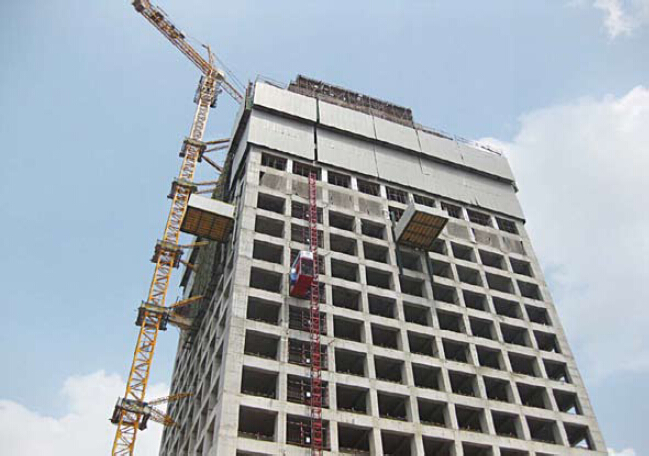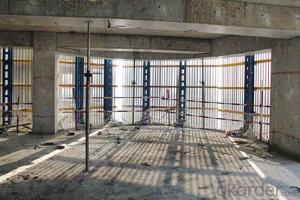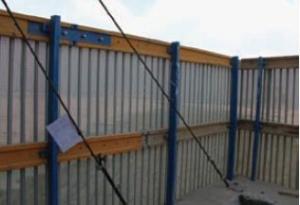Protection Platform for Formwork and scaffolding systems
- Loading Port:
- Tianjin
- Payment Terms:
- TT OR LC
- Min Order Qty:
- 50 m²
- Supply Capability:
- 1000 m²/month
OKorder Service Pledge
OKorder Financial Service
You Might Also Like
Protection Platform PP-50
A kind of new type construction protection system, applying operating platform and safer job
location for construction corps.
Characteristics:
◆ Easy and quick assembling.
◆ Lifted as a group, it is rapid and economic.
◆ Auto-climbing
◆ A safe and reliable anchor system
1. Composition
2. Assembly process of anchor system
(1) Embed V-climbing cone and anchor plate into the slab.
(2) Fix anchor shoe on the slab by tensile bolt.
(3) The fixed anchor shoe.
◆ High work efficiency with work platform and unload platform
◆ High light transmittance with the hollow block


- Q:Can steel formwork be used for office building construction projects?
- Office building construction projects can indeed utilize steel formwork. This option, known for its versatility and durability in concrete construction, presents numerous advantages. With its exceptional strength and stability, steel formwork can withstand the pressures and loads encountered throughout the construction process. Furthermore, its reusability renders it a cost-effective choice for extensive undertakings such as office buildings. Moreover, the assembly and disassembly of steel formwork are effortless, facilitating swift and efficient construction and enabling faster turnaround times. Overall, steel formwork stands as a fitting choice for office building construction projects due to its robustness, longevity, cost-effectiveness, and efficiency.
- Q:Can steel formwork be used for curved beams and columns?
- Yes, steel formwork can be used for curved beams and columns. Steel formwork is flexible and can be easily shaped to meet the specific curves and shapes required for curved beams and columns. It offers a high level of strength and durability, making it suitable for supporting the weight and pressure of the concrete during the construction process. Additionally, steel formwork allows for accurate and precise construction of curved elements, ensuring that the final product meets the desired specifications.
- Q:What are the different types of joints used in steel formwork?
- Steel formwork for construction projects commonly utilizes various types of joints to ensure stability and proper alignment of the system. 1. The most basic joint is the butt joint, which involves placing two formwork panels together with their edges abutting. Additional reinforcement, such as steel plates or angles, is often used to enhance strength and stability. 2. Corner joints, as the name suggests, connect formwork panels at corners. These joints are usually reinforced with steel angles or brackets to ensure proper alignment and support. 3. T-joints are used when formwork panels intersect at a perpendicular angle. This joint involves connecting three panels together, with one positioned perpendicular to the other two. 4. L-joints are similar to T-joints but are used when panels intersect at a 90-degree angle. This joint involves connecting two panels together, with one positioned perpendicular to the other. 5. Lap joints are used to connect long formwork panels, creating a continuous surface. This joint involves overlapping the edges of two panels and securing them with bolts or clamps. 6. Hinged joints are employed when adjustable or movable formwork panels are required. This joint allows for flexibility in placement and can be locked in different positions to accommodate various shapes and sizes. It is essential to consider the specific requirements of the construction project, including the desired formwork system and structural design, when selecting the appropriate joint. This selection plays a crucial role in ensuring the overall stability and strength of the formwork system.
- Q:Can steel formwork be used in airport or transportation infrastructure projects?
- Steel formwork is a viable choice for airport and transportation infrastructure projects. It is a flexible and long-lasting option for construction endeavors, particularly those in the airport and transportation sectors. It boasts numerous advantages, including its capacity to bear heavy loads, its simplicity when it comes to assembly and disassembly, and its ability to withstand harsh weather conditions and extensive usage. Moreover, steel formwork guarantees exceptional dimensional accuracy, ensuring precise and consistent outcomes. Additionally, it can be easily reused, making it a cost-effective alternative for extensive undertakings like airports and transportation infrastructure. In general, steel formwork is a suitable and efficient solution for constructing different elements in airport or transportation projects, such as foundations, columns, beams, and slabs.
- Q:How does steel formwork affect the overall project budget?
- The overall project budget can be significantly impacted by steel formwork. Although steel formwork may be more expensive initially compared to other types of formwork like timber or plywood, it provides several advantages that can ultimately result in cost savings. Durability is one of the main benefits of steel formwork. Steel is a strong and long-lasting material that can withstand multiple uses without wearing down. This means that steel formwork can be reused for many projects, reducing the need for frequent replacements and lowering long-term costs. In addition, steel formwork allows for faster construction times. Its strength and stability enable contractors to pour concrete more quickly, reducing labor costs and streamlining the construction process. Moreover, steel formwork can be easily put together and taken apart, resulting in shorter intervals between projects. Steel formwork also ensures high-quality concrete structures with precision and consistency. This can minimize the need for rework and corrections, thereby reducing costs associated with fixing errors or imperfections. Furthermore, steel formwork offers design flexibility. It can be customized to fit different shapes and sizes, providing greater architectural freedom and creativity. This versatility can lead to cost savings by eliminating the need for expensive and complex modifications to the formwork system. Lastly, steel formwork is resistant to moisture and weather conditions. Unlike timber or plywood, steel does not warp or deteriorate when exposed to moisture, which can save costs by avoiding replacements or repairs due to water damage. To summarize, although steel formwork may be initially more expensive, its durability, reusability, speed, precision, flexibility, and resistance to environmental factors can result in overall cost savings throughout the project. By considering the long-term benefits and efficiencies offered by steel formwork, project budgets can be effectively managed and optimized.
- Q:How much weight can steel formwork support?
- The weight capacity of steel formwork is influenced by several factors, including the thickness and type of steel, the formwork's design and construction, and the support system in place. Steel formwork is renowned for its strength and durability, making it capable of withstanding heavy loads. Typically, steel formwork can bear a substantial amount of weight, ranging from a few hundred kilograms to several tonnes. However, it is crucial to ensure that the formwork is appropriately designed, installed, and supported in order to safely accommodate the intended load. To determine the precise weight capacity of the steel formwork being used, it is advisable to consult with structural engineers or adhere to the manufacturer's guidelines.
- Q:Can steel formwork be used for airport runway construction?
- Yes, steel formwork can be used for airport runway construction. Steel formwork is a durable and versatile option that can withstand heavy loads and provide a smooth surface for concrete placement. It is commonly used in large-scale construction projects like airports due to its strength, stability, and ability to be reused multiple times, making it an ideal choice for runway construction.
- Q:What are the different accessories required for steel formwork maintenance?
- Some of the different accessories required for steel formwork maintenance include formwork release agents, cleaning solutions, wire brushes, repair materials such as epoxy or cementitious grout, lubricants for hinges and pins, and protective coatings for corrosion prevention. Additionally, tools such as hammers, wrenches, and pliers may be needed for minor repairs or adjustments.
- Q:How does steel formwork compare to aluminum formwork in terms of performance?
- Steel and aluminum formwork are commonly used materials in the construction industry to create temporary molds or structures that hold concrete in place until it becomes solid. When comparing these materials, it is important to consider their performance aspects. In terms of performance, steel formwork is known for its strength and durability. It can withstand heavy loads and rough handling, making it suitable for heavy-duty applications. Steel formwork also maintains its shape during the concrete pouring process, resulting in accurate finishes. It can be easily customized to meet project requirements. On the other hand, aluminum formwork is preferred for its lightweight nature. It is easy to handle, transport, and assemble, reducing labor costs and construction time. It also has excellent corrosion resistance, making it suitable for coastal areas or humid environments. Additionally, aluminum formwork provides a smooth surface finish on the concrete, requiring minimal treatment. The choice between steel and aluminum formwork depends on the specific project requirements. Steel formwork is ideal for projects with heavy loads or high reuse needs due to its strength and durability. On the other hand, aluminum formwork is a better choice for projects that require quick assembly, easy handling, and a smooth surface finish. Ultimately, the selection of formwork should be based on a careful evaluation of the project's needs, budget, timeline, and other factors such as cost, maintenance, and environmental impact.
- Q:How does steel formwork contribute to the overall acoustics of the structure?
- Steel formwork does not directly contribute to the overall acoustics of a structure as its primary function is to provide support and shape during the construction process. The acoustics of a building are primarily influenced by the design and materials used for the walls, ceilings, and floors, which are usually installed after the steel formwork is removed.
1. Manufacturer Overview |
|
|---|---|
| Location | |
| Year Established | |
| Annual Output Value | |
| Main Markets | |
| Company Certifications | |
2. Manufacturer Certificates |
|
|---|---|
| a) Certification Name | |
| Range | |
| Reference | |
| Validity Period | |
3. Manufacturer Capability |
|
|---|---|
| a)Trade Capacity | |
| Nearest Port | |
| Export Percentage | |
| No.of Employees in Trade Department | |
| Language Spoken: | |
| b)Factory Information | |
| Factory Size: | |
| No. of Production Lines | |
| Contract Manufacturing | |
| Product Price Range | |
Send your message to us
Protection Platform for Formwork and scaffolding systems
- Loading Port:
- Tianjin
- Payment Terms:
- TT OR LC
- Min Order Qty:
- 50 m²
- Supply Capability:
- 1000 m²/month
OKorder Service Pledge
OKorder Financial Service
Similar products
New products
Hot products
Hot Searches
Related keywords























